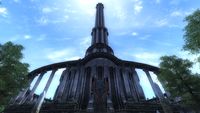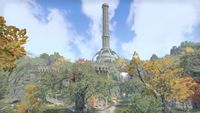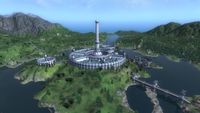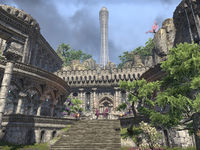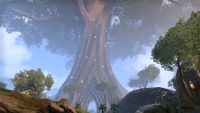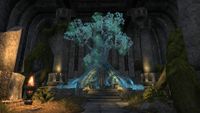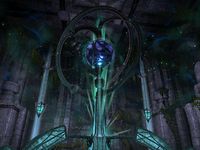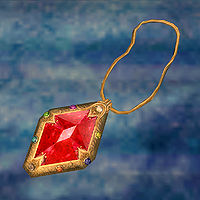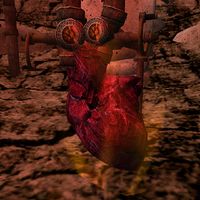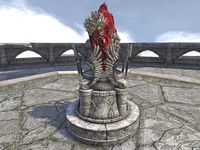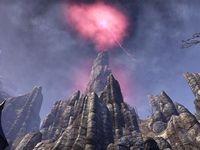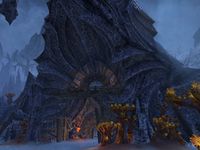Lore:The Towers
| It has been proposed that Lore:The Towers be renamed and moved to Lore:Towers. To leave a message about the renaming of this article, please add it to this article's talk page |
This article is about the metaphysical structures. For the constellation, see The Tower.
—Prince Attrebus Mede, The Infernal City
The Towers are ancient structures on Nirn which date back to as early as the end of the Dawn Era. They are immensely powerful, and are responsible for the stabilization of Mundus as well as a wide array of other fantastical functions. The Towers are capable of causing extreme alterations in reality that can result in Dragon Breaks.[1]
The Metaphysical Tower[edit]
The Towers of Nirn are magical and physical echoes of Ada-Mantia which are believed to strengthen and reinforce the strictures of Mundus.[2] The Towers' relation to the metaphysical Tower is unclear, but presumably, understanding both is necessary to understand either.[UOL 1]
The Wheel[edit]
The Wheel is the structure of the Aurbis. The Spokes are "eight components of chaos", believed to be referring to the Divines and the primordial force of Padomay. They are the "lent bones" (i.e. Earth Bones) of the Aedra, those who formed the earth upon which mortals tread and gave them the blending of the primordial forces of Anu and Padomay: static change. Outside the spokes is the Aurbis,[3] though this is probably better understood in context as Aetherius, the spirit realm, the rim of the Wheel.
The spaces between the Spokes are Oblivion, the realms of the Daedric Princes. Mundus is the Wheel's hub.[3]
The Secret[edit]
The Tower represents an objective view of reality, and those trying to follow Lorkhan's path attempt to achieve this view without sacrificing their own sense of agency and personhood. If a mortal is successful in observing the Tower, they can achieve CHIM.[UOL 2]
Mundus is often depicted in the form of the Wheel, which is considered the heart of all creation. At the center of this Wheel lies a smaller circle, which, when viewed from the side, is revealed to be a Tower.[4] This is known as the “I”, or secret Tower. The White-Gold Tower and its spokes are built to emulate this particular depiction of the Aurbis. Mundus is a reflection of the Wheel as a whole, being its hub (the center). Mortals, living within this 'hub', are able to perceive the Tower within Mundus without leaving the 'Wheel'.
Those who reach a true understanding on the nature of the universe, the nature of the Tower, are sometimes said to know a "Right Reaching".[4][3][5] Vivec also wrote of the "secret triangular gate" of the Heart of Lorkhan through which mortals could perceive the secret Tower.[3]
Those who take a favorable view of the creation of the mortal plane assert that Lorkhan came up with this idea so that others could find what he did.[UOL 2] Lorkhan's motivations for this have been heavily disputed throughout history.[6] All agree that he failed,[7] but some assert that he sabotaged his experiment with the Tower intentionally so that others would know how to avoid doing so.[UOL 2]
The Towers of Nirn[edit]
—Aurbic Enigma 4: The Elden Tree
According to legend, when the Aedra undertook the creation of Mundus, the physical flesh of Nirn was hung on a skeleton of joints, which are known as the Earth Bones. Each of them radiated a palpable reality. The Adamantine Tower was erected for Convention atop one of these joint-points.[8]
During the Merethic Era, the Aldmeri devised a way for "Variorum Architects" to inscribe rules for new Towers. They self-refracted, with different groups following different Towers and Stones, resulting in the proliferation of the Towers which are known today,[9] each of them built on other "joint-points".[8] These legends suggest that while time was linear in the Merethic Era, it was not singular: by building their own Tower, each group could create their own narrative, distinct but equal to those around it. And so, the Towers did their "Dance",[9] each harnessing their own reality and making it conform to their desires. It is speculated that the Towers will conform their spheres of reality according to the desires of whomever claims them; this is offered as a possible explanation for an apparent climate change in Cyrodiil.[8]
The Towers exist apart from ordinary space and time.[10] Each Tower has, for the most part, its own unique appearance and abilities. Some Towers are meticulously crafted reflections of Ada-Mantia, as is the case with White-Gold.[11] Others, like Crystal-Like-Law, took a more liberal approach to their designs. Some Towers are even natural formations, such as Snow Throat.[12] Some, though echoes of Ada-Mantia, are considered refutations of that Tower, at least one (Walk-Brass) to such a great degree that it apparently refuted itself into nonexistence.[UOL 1]
Every Tower has its Stone.[9] They are magical and physical echoes of Ada-Mantia's Zero Stone, by which a Tower might focus its energy to mold creation.[UOL 1] While Aetherius is the source of "creatia", accessing the spirit realm is difficult and requires great expenditures.[13][UOL 1] Therefore, the general rule is that Stones cultivate creatia indirectly, borrowing surplus creatia which has washed into Oblivion from Aetherius. The Stones then graft this creatia to the terrestrial domain of their respective Towers.[UOL 1]
"Tower Lore" is notoriously riddled with scholarly disagreement and controversy.[8] Much of the lore surrounding the subject is thought to be muddled by lies and misinterpretations.[UOL 1] Below are the most well-known of the Towers of Nirn, though it's possible others may exist. In some instances, a Tower's physical avatar within Mundus has been inferred.[nb 1]
Ada-Mantia[edit]
—Pocket Guide to the Empire, Third Edition
The tower on the Isle of Balfiera is known by many names: Tower Zero,[11] Adamantine, Ada-Mantia,[9] Direnni,[14] and the Ur-Tower[UOL 1] are but a few. It was the site of Convention, and is the single oldest building in all the known world.[15] Legend holds that linear time began around the tower - which defined the structure of reality within its vicinity[9] - and spread from there in a stepped fashion.[UOL 1] It was this tower which would be emulated across Tamriel.[9] Architects have noted that building a tower to its proportions should not be possible.[14]
Ada-Mantia's Stone is the Zero Stone, which is still within the Foundation Vault of the tower.[9] It is undoubtedly filled with immense power, but has remained inert and immutable throughout history despite attempts by some of the greatest mages in history to unravel its secrets.[16] It was through this Stone that the powers of Ada-Mantia at Convention determined the spread of creation and their parts in it.[UOL 1]
Convention consisted of two known decisions: the punishment of Lorkhan, and the decision of et'Ada to either leave Mundus or stay.[15][7] The "First Tower Dictate" is said to have consisted of the command to "render the mutant bound where he may do no more harm. As God of the Mundus, alike shall be his progeny, split from their divine sparks. We are Eight time eight Exarchs. Let the home of Padomay see us as sole exit".[1] The apex of Ada-Mantia is where Auri-El is said to have slain Lorkhan, impaled his Heart on an arrow, and launched it across the world.[14][7] Even after the Aedra left, Ada-Mantia continued to dictate reality in its vicinity, bringing unrelenting order to the chaos of the Dawn.[9]
The facade has changed over the years, but the core of the tower has remained entirely the same: a single great, seamless, impregnable spire of ageless metal which is at least half-embedded in the ground.[17] It is entirely smooth, except for one point known as the Argent Aperture which is thought to be a door. Adjacent to the Zero Stone, this door has a lock of thirteen slowly counter-rotating rings. It has never been opened.[16]
Red Tower[edit]
When the Merethic elves took their own paths, the Chimer followed Red-Heart.[9] When the Heart of Lorkhan fell to the ground in what is modern-day Morrowind, Red Mountain (also known as the Red Tower) rose around it, the second of the Towers whose creation can be directly attributed to the Aedra themselves.[7]
Auri-El launched the Heart of Lorkhan across the world because he could not destroy it. It is the Heart of the World, and merely laughed at his efforts. As the Aedra sought to leave the world for its own good at Convention, the raw power of the Heart was essential in order for the world to survive in their absence.[7] The Dwemer found the Heart buried deep beneath the mountain, and High Craftlord Kagrenac sought to harness its power in the building of a mechanical god for the Dwemer.[18] This is where the story of the Tower of Walk-Brass begins.
Using Kagrenac's achievements, four Chimer eventually tapped into the power of the Heart: the Tribunal of Almalexia, Sotha Sil, and Vivec wielded the divine power of the Heart for thousands of years for the benefit of their people.[18] Their former compatriot, Dagoth Ur, awoke beneath the mountain circa 2E 882. Dagoth Ur would eventually succeed in hoarding the power of the Heart of Lorkhan for himself, and the Tribunal would lose access to the stone of Red Mountain entirely.[19]
However, with the fulfillment of the Nerevarine Prophecies in 3E 427, Kagrenac's bindings upon the Heart were destroyed: the Heart of the World was set free. All who had stolen power from it lost their divine spark, and the threat Dagoth Ur posed to Tamriel was quickly eliminated.[20]
White-Gold[edit]
The Ayleids built their White Gold Tower to reflect Tower Zero, Ada-Mantia, in the center of Tamriel, in order to best echo and even amplify Ada-Mantia's mystical properties.[8] They used the Chim-el-Adabal as their Stone, as it was purportedly the crystallized blood from the Heart of Lorkhan which fell to the ground as the Heart sailed over the Heartlands. Through their powerful machinations, their tower of White-Gold became Tower One (though history records that Crystal-Like-Law was erected before the White Gold Tower[15]).[9] It has also been called simply the White Tower.[21] The Ayleids' purpose in building their Tower was to counteract the spiritual bleeding from Mundus caused by the Convention at Ada-Mantia, to make a focus point for reuniting the mortal realm with the divine. To this end, they entered into a pact with the Daedric Princes to harvest castaway creatia from the Void.[UOL 1]
It is noteworthy that the Ayleids built more than just the central tower: with eight lesser towers forming a ring around White-Gold, the Ayleids had built their own Wheel, which apparently gave the Tower of White-Gold a power over creatia unlike any other Tower. This special power also made White-Gold especially dangerous, for if the Ayleids succeeded in making their own Wheel, their own microcosm within a microcosm, then if and when it was meddled with, the consequences could prove absolutely disastrous.[UOL 1]
In 1E 243, the Alessian Slave Rebellion came to a head, and the armies of man, led by Morihaus, took the White Gold Tower.[22][23] Though the Ayleids lost their Tower, it did not fall. Rather, the legend of Saint Alessia and her new Covenant with Akatosh began. It is said that her rebellion was blessed by Akatosh, who looked with pity upon the plight of her people. He drew his own blood and blessed Alessia with it, forging their pact: so long as Alessia's generations were true to the dragon blood, Akatosh would endeavor to seal tight the Gates of Oblivion and deny the armies of Daedra and undead to their enemies. In token of this Covenant, Akatosh gave to Alessia and her descendants the Amulet of Kings (whose centerpiece was the Chim-el Adabal), as well as the Dragonfires of the Imperial City. So long as the Empire maintained its worship of Akatosh and his kin, and so long as Alessia's heirs bore the Amulet of Kings, Akatosh and his divine kin would maintain a strong barrier protecting the mortal plane.[24]
Mortals did not always prove capable of holding to this Covenant. During the Interregnum in the Second Era, the Amulet of Kings had no master, with devastating results for all of Tamriel.[25] Around 2E 582, servants of Molag Bal removed many Tel Var Stones from the Tower, weakening it, before their Prince's attack on Tamriel could be thwarted.[26] But an age later, servants of a different Prince, Mehrunes Dagon, brought about the Oblivion Crisis by slaying the Emperor and any other who could lay claim to the Amulet, until all that was left was Martin Septim, the slain Emperor's bastard son. As Dagon and his armies rained devastation down upon the Imperial City to thwart his coronation, Martin ended the Crisis by forging a new agreement between mortals and the gods, again written in blood — this time, his own. He shattered the Amulet of Kings, transforming himself into an avatar of Akatosh and vanquishing Dagon, jettisoning the Prince of Destruction back into Oblivion.[27] With the Amulet gone, the Dragonfires quenched, and the last Dragonblood Emperor dead, the barrier to Oblivion is sealed forever.[28] At the cost of his own life, Martin ensured that the Daedric Princes would never again tread upon the mortal realm.[UOL 3]
Crystal-Like-Law[edit]
—Rising Threat
The Crystal Tower was one of the first towers erected in emulation of Ada-Mantia, possibly the very first.[15] In erecting Crystal-Like-Law, the elves of Summerset Isle sought to focus on "dracochrysalis", or keeping elder magic bound before it could change into something lesser (an act which, ironically, required aetherial surplus).[UOL 1] The Crystal Tower was a manifestation of ancient magic and a symbol for the Altmer. It protected Summerset, and connected every reality by existing in every planar realm at the same time. Sotha Sil theorized that it functioned as a doorway or watchtower, and described it as the "key to omnipresence".[29] The Sapiarchs, Summerset's greatest sages, served as the Tower's curators.[30]
The white interior of the tower was said to radiate light.[31] The Stone of Crystal-Like-Law is Transparent Law, a large red crystal which sits at the top of the Tower and serves as the source of its power, anchoring the Tower to other realities.[29] Embedded within Transparent Law is a smaller gem called the Heart of Transparent Law. If the Heart of Transparent Law is removed from the crystal, the protection provided by the Tower slowly weakens. At some point in the early Second Era, the Psijic Ritemaster Iachesis was compelled to steal the Heart from the Crystal Tower.[32] An outsider used the divine power of the Dawnbreaker to reforge it in 2E 582.[33] For the people of Summerset, the tower was the heart of their homeland, a heart which was ripped out during the Oblivion Crisis. Before Martin Septim could close shut the jaws of Oblivion, the hordes of Daedra attacking the homeland of the Altmer were able to use magic to topple their tower. Crystal-Like-Law had fallen.[34] However, appearances may be deceiving, for this bastion of sorcery seemingly transcended normal conceptions, existing in many planes other than Mundus.[32][33][35]
Snow Throat[edit]
Snow Throat, or the Snow Tower,[21] is represented in the Throat of the World. Its apex is said to be only "half here",[UOL 1] and its Stone is thought to be a cave.[UOL 4] It was here that many significant historical and mythical events for the Nordic people took place, not the least of which is Kyne purportedly creating mankind at its summit.[22]
In the late Merethic Era, the Dragon War was ended atop the Throat of the World when three Atmoran warriors utilized an Elder Scroll atop Snow-Throat to cast the dragon god Alduin out of the world.[36] This action resulted in the creation of a Time Wound, or "Tiid-Ahraan", at the peak, which the turncoat dragon Paarthurnax guarded against for when Alduin inevitably returned.[37] Eventually, Jurgen Windcaller would come to the summit in the early First Era and built High Hrothgar, a monastery for individuals to contemplate the nature of the universe and peacefully master their thu'um's.[38]
"The Prophecy of the Dragonborn", which is usually attributed to the Elder Scrolls (though it's sometimes called an Akaviri prophecy), mentions with several other Towers while holding a special significance for Snow Throat:
- When misrule takes its place at the eight corners of the world
- When the Brass Tower walks and Time is reshaped
- When the thrice-blessed fail and the Red Tower trembles
- When the Dragonborn Ruler loses his throne, and the White Tower falls
- When the Snow Tower lies sundered, kingless, bleeding
- The World-Eater wakes, and the Wheel turns upon the Last Dragonborn.
This prophecy is shown on the right-hand side of Alduin's Wall in Sky Haven Temple, where the Snow Tower is depicted as a cracked mountain.
The Prophecy's reference to the Snow Tower has been widely construed as referring to the plight of Skyrim during the Stormcloak Rebellion, wherein High King Torygg was killed and the province was launched into a bitter civil war. Following this event, Alduin was at last able to re-emerge from the Time Wound and began the process of rebuilding his dragon army. The Last Dragonborn would climb the Throat of the World and learn the thu'um the ancient Atmorans used to weaken him through the use of the Time Wound and another Elder Scroll, sealing the wound in the process. What this meant for the status of Snow-Throat is unknown.[36]
Green-Sap[edit]
—Morian Zenas, Commentaries on Beredalmo[39]
The Bosmer did not build a Tower; they grew it, a great graht-oak whose roots sprang from a Perchance Acorn. This was their Stone. And because the Acorn might perchance have been elsewhere, thus was Green-Sap manifold and several. Each could walk, and sing their own songs. From the interplay of the manifold Green-Sap, the Bosmer learned the songs which "made the trees dance", and which dances they desired to perform.[9] In other words, each Green-Sap was able to sing their own song, tell their own story — create their own reality. And the Bosmer took joy in this, and in picking the song which appealed to them, as it was a reflection of their own nature.
Each Green-Sap was also every Green-Sap. Within each were told all the stories of the Green, with every ending true, though none any truer than another. When the Alessian Slave Rebellion caused the Ayleids to flee Cyrodiil, many of them were welcomed by the Bosmer of Valenwood, so long as their cousins agreed not to dissonate the greensong of Green-Sap. All agreed to this, save the arch-mage Anumaril.[9]
Before the taking of the White Gold Tower by Morihaus during the Alessian Slave Rebellion in 1E 243,[22][23] Anumaril created the Staff of Towers, which was composed of eight segments, each one a semblance of a Tower in its Dance. White-Gold Knights took seven of these segments and carried them off to hide them in distant Fold-Places. Anumaril left with the eighth, disguised as a femur - this was Segment One, a semblance of Tower One, and thus also a reflection of Tower Zero.[9]
When Anumaril fled to Valenwood, he still carried with him Segment One. He asked the Great Camoran to show him Green-Sap, and was brought to one that by happenstance stood then in Elden Root. There, he found a Perchance Acorn. To this golden nut, Anumaril showed the segment. For the first time, the greensong knew only one ending. And so, that ending became definite, and the Perchance Acorn became a Definite Acorn. That Elden Tree would not walk again.[9] This tree, also called the First Tree, or the Great Tree, is found in the Elden Grove. Life itself seems to be stronger around it,[40] and it is believed to be the tree that seeded all of Valenwood.[41] As written in an Ayleid prophecy, "All things to the Tree. From the Tree, all things".[40]
Using his dentition as tonal instruments, Anumaril dismantled his bones and built of them a Mundus-machine that mirrored Nirn and its planets. And when he had used all his substance in fangling this orrery, the Orrery of Elden Root, he placed the segment-sceptre within, hiding it between the Moons. Through these efforts, he had hoped to convert Green-Sap into White-Gold, and thereby remake the Ayleids' realm. But Anumaril's plan went awry for reasons he could not have anticipated. His Ayleid magic was concerned with "Will, and Shall, and Must—but under Green-Sap, all is Perchance".[9]
According to legend, if any person stepped into the center of this orrery when it was activated, it would reveal their inner self. Prince Naemon, younger brother to Queen Ayrenn of the Aldmeri Dominion, learned this lesson well shortly before his death circa 2E 582. After betraying his sister and entering the orrery, he briefly glimpsed a vision of the White Gold Tower, and then found himself painfully transformed into a large ogrim. He flew into a rage and was quickly killed.[25]
Anumaril's plan did not necessarily fail, as his machinations presumably continue. So, while the ending to the story of Green-Sap is determined, that ending still remains a mystery.[9]
Orichalc[edit]
Orichalc is one of the most mysterious of the Towers; little is known beyond the name.[42] Some Redguards venerate Diagna, the "Orichalc God of the Sideways Blade", an avatar of the HoonDing which managed to "achieve permanence" and thus entered into the pantheon of the Crowns.[43] The Stone of Orichalc is said to be a sword.[UOL 4] According to a story, Diagna crashed his fist against The HoonDing Gong and swords fell from the walls of the Orichalc Tower like needles from a dry pine.[44] It is suspected that Orichalc was found in Yokuda, and may have been related to the Lefthanded Elves. With Yokuda thought to have gone underwater, Orichalc is supposedly sunken along with it.[42]
Circa 2E 582, while aiding the Psijic Order in restoring the Staff of Towers, the Augur of the Obscure described it as an "ugly, sunken, long-forgotten [thing]" when the Vestige found the fragment associated with this Tower.[42] This commentary lends credence to the theory that it sank with Yokuda, although the Augur was regarded by the Psijics as a notorious liar when it was not being asked a direct question.[45]
Walk-Brass[edit]
In Walk-Brass, also called the Brass Tower and the Brass God, the Dwemer sought to make their own god. Their ambulatory, usually anthropomorphic Tower is better known to most as the Numidium or Anumidium.[21] The book Divine Metaphysics is an explanation of how the Dwemer planned to make this new god using Kagrenac's tools and the sacred tones of the Heart of Lorkhan.[46]
It is thought that Anumidium was meant to be used many times to transcend Nirn. High Craftlord Kagrenac conceived its construction, which required that Dwemer sacrifice their souls to create its body, with the intention of leading them to transcendence and salvation.[UOL 5] Kagrenac's plan was interrupted by Dagoth Ur's discovery of his intentions, which led to the Battle of Red Mountain circa 1E 700 wherein all Dwemer on Nirn disappeared.[18] Misuse of the golem they left behind (which, historically, has proven to be every known use) is believed to have terrible long-term metaphysical consequences.[47] Some believe that the Numidium is intrinsically evil: a ranking Clockwork Apostle refers to it as the "most profane" of the Dwemer's creations, a "walking horror" and the "Antipodal-God-Thing that reigns on the darkest pole of the sacred Nirn-Sphere".[48]
Pieces of the golem, called Numidium, fell into the hands of the Tribunal, who eventually traded them to Tiber Septim as part of their Armistice with the latter's Empire in 2E 896. In the town of Rimmen in Elsweyr, it was slowly reassembled and finally activated.[47] Though it was meant to be infused with the Heart of Lorkhan, Tiber's Battlemage Zurin Arctus devised a way to create the Mantella to function as the Numidium's heart.[49] Tiber was able to conquer the whole continent using the Numidium, becoming the first Emperor of Tamriel and ending the Second Era.[49][50] The Numidium was used again in 3E 417 to bring about the Miracle of Peace in the Iliac Bay region,[51] but it was apparently destroyed in the process.[52]
These successes served as inspiration for a new golem, known as Akulakhan or the Second Numidium, which Dagoth Ur was building beneath Red Mountain as part of his plan to drive the foreigners out of Morrowind and then conquer Tamriel. Like Anumidium, Akulakhan was to be powered by the Heart of Lorkhan.[19] When the Nerevarine freed the Heart from Kagrenac's bindings in 3E 427, this Second Numidium was destroyed.[20]
Gallery[edit]
-
The reconstructed Coral Tower in Coldharbour
Notes[edit]
- The Doomcrag in Rivenspire is believed to have been a failed imitation of a Tower.[53][54]
- It is unknown whether the Coral Tower of Thras, destroyed during the invasion of the All-Flags Navy, was a functional Tower or a failed imitation like the Doomcrag.[55]
- It is unknown if The Tower, a constellation, is related to the Towers. One source, however, states that it protects Mundus from chaotic, Padomaic influences.[UOL 6]
- Shortly after describing Numidium as the "Brass Tower of Vanity",[48] a disciple of Sotha Sil terms the Clockwork City "Brass-Throat" and the "Oil-Slick Tower of Seamless Assembly" in The Truth in Sequence.[56] Another book by a Clockwork Apostle terms the City "the center of the wheel for Nirn-Ensuing".[57] Mephala's servant, the former Psijic Earl Leythen, describes the Clockwork City as a "place of power", similar to the Crystal Tower, that can "change the rules of reality and remake the world".[58]
- A disciple of the Daedric Prince Mephala asserts that her Pillar Palace, "whose true name is too awful to be uttered", is a Tower. "Like Nirn", it is said to stand at the center of her realm surrounded by eight strands that are like spokes.[59]
- When asked about the Stone of Falinesti, Michael Kirkbride said it was "a fruit".[UOL 4]
See Also[edit]
- 36 Lessons of Vivec, Sermon 21 by Vivec — Book 21 of a series of words of wisdom relating to Vivec
- The Amulet of Kings by Wenengrus Monhona — Chronicles the creation of the Amulet of Kings
- Aurbic Enigma 4: The Elden Tree Inscribed by Beredalmo the Signifier — The story of Green-Sap, the Tower of the Bosmer
- The Book of the Dragonborn by Prior Emelene Madrine — A treatise on the Dragonborn
- Mythic Dawn Commentaries 3 by Mankar Camoran — The third book read by initiates to the Mythic Dawn cult
- Subtropical Cyrodiil: A Speculation by Lady Cinnabar of Taneth — Thoughts on the climate of Cyrodiil and its relationship to the White-Gold Tower
- Tower of Adamant by Hrerm House-builder, Bards College, Solitude — A Nord architect's notes on the construction of the Adamantine Tower
References[edit]
- ^ a b Mythic Dawn Commentaries 3 — Mankar Camoran
- ^ The Infernal City — Greg Keyes
- ^ a b c d 36 Lessons of Vivec, Sermon 21 — Vivec
- ^ a b On the Detachment of the Sheath — Arch-Prelate Fervidius Tharn
- ^ The Illusion of Death
- ^ Spirit of Nirn, God of Mortals
- ^ a b c d e The Monomyth
- ^ a b c d e Subtropical Cyrodiil: A Speculation — Lady Cinnabar of Taneth
- ^ a b c d e f g h i j k l m n o p Aurbic Enigma 4: The Elden Tree — Beredalmo the Signifier
- ^ Loremaster Celarus's dialogue in ESO: Summerset
- ^ a b Beacon of Tower Zero furnishing name, appearance and Codex entries in ESO
- ^ Appearance of the Throat of the World in Skyrim
- ^ Pocket Guide to the Empire, 3rd Edition: Arena Supermundus: The Tapestry of Heaven — Imperial Geographical Society, 3E 432
- ^ a b c Tower of Adamant — Hrerm House-builder, Bards College, Solitude
- ^ a b c d Before the Ages of Man — Aicantar of Shimerene
- ^ a b Once — Beredalmo the Signifier
- ^ Pocket Guide to the Empire, 1st Edition: High Rock — Imperial Geographical Society, 2E 864
- ^ a b c The Battle of Red Mountain — Vivec
- ^ a b Dagoth Ur's Plans — Tribunal Temple
- ^ a b Events of Morrowind
- ^ a b c The Book of the Dragonborn — Prior Emelene Madrine
- ^ a b c Varieties of Faith... — Brother Mikhael Karkuxor of the Imperial College
- ^ a b Pocket Guide to the Empire, 3rd Edition: All the Eras of Man, A Comprehensive History of our History — Imperial Geographical Society, 3E 432
- ^ The Amulet of Kings — Wenengrus Monhona
- ^ a b Events of ESO
- ^ Phrastus of Elinhir's dialogue in ESO
- ^ Events of Light the Dragonfires in Oblivion
- ^ The Oblivion Crisis — Praxis Sarcorum, Imperial Historian
- ^ a b Sotha Sil's dialogue during A Necessary Alliance in ESO
- ^ Ritemaster Iachesis's dialogue during The Tower Sentinels in ESO
- ^ King Edward
- ^ a b Ritemaster Iachesis's dialogue during Buried Memories in ESO
- ^ a b Events of The Crystal Tower in ESO
- ^ Rising Threat — Lathenil of Sunhold
- ^ The Crystal Tower loading screen in Arena
- ^ a b Events of Skyrim
- ^ Paarthurnax's dialogue in Skyrim
- ^ Pocket Guide to the Empire, 1st Edition: Skyrim — Imperial Geographical Society, 2E 864
- ^ The Orrery loading screen in ESO
- ^ a b The Book of the Great Tree
- ^ Ayleid Cities of Valenwood — the Esteemed Historian Homfrey at the University of Gwylim, 2E 455
- ^ a b c Augur of the Obscure's dialogue in ESO
- ^ Varieties of Faith, Crown Redguards — Brother Mikhael Karkuxor of the Imperial College
- ^ Lefthander's Aegis Belt codex entry in ESO: High Isle
- ^ Josajeh's dialogue during The Psijics' Calling in ESO
- ^ Baladas Demnevanni's dialogue in Morrowind.
- ^ a b Where Were You ... Dragon Broke — Various
- ^ a b The Truth in Sequence: Volume 5 — Deldrise Morvayn
- ^ a b The Arcturian Heresy — The Underking, Ysmir Kingmaker
- ^ Darius' dialogue in Morrowind
- ^ Events of Daggerfall
- ^ Janand Maulinie's dialogue in Morrowind
- ^ The Doomcrag's loading screen in ESO
- ^ Telenger the Artificer Answers Your Questions 2 — Telenger the Artificer
- ^ Further Notes on the Sload — Telenger the Artificer
- ^ The Truth in Sequence: Volume 6 — Deldrise Morvayn
- ^ The Unseen Potential of Clockwork — Lector Saelorn Tenar, Apostle of Sotha Sil
- ^ Earl Leythen's dialogue during A Necessary Alliance in ESO
- ^ Rumors of the Spiral Skein — the Derisive Necromite
Note: The following references are considered to be unofficial sources. They are included to round off this article and may not be authoritative or conclusive.
- ^ a b c d e f g h i j k l m Nu-Mantia Intercept — Nu-Hatta, The Imperial Library
- ^ a b c Vehk's Teachings — Vivec, The Imperial Library
- ^ Interview with Todd Howard
- ^ a b c Michael Kirkbride interview, The Imperial Library
- ^ Skeleton Man's Interview with Denizens of Tamriel, The Imperial Library
- ^ Six Views of the Egg of Time, V. III
